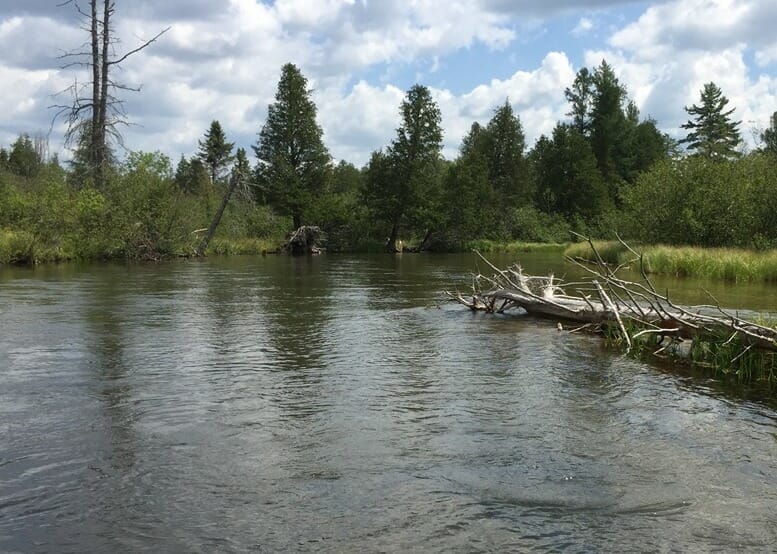
Goals:
With more than 20 percent of the Earth’s available freshwater flowing through its rivers, streams and lakes, the Great Lakes basin is an unparalleled natural resource. An immense network of coldwater rivers and streams exists, among many other important aquatic ecosystems, providing anglers with a variety of unique opportunities. Whether it is fishing for brook trout in small headwater streams or steelhead and salmon in larger rivers and in the Great Lakes, the region supports thriving fisheries and sustains a $4 billion sports fishery industry.
Despite the often pristine conditions found throughout the region, opportunities exist for restoration and enhancement. Past and present human disturbance,s along with the predicted patterns of climate change, pose a threat to coldwater ecosystem integrity, resiliency and the ability of coldwater fish to thrive. Throughout the Great Lakes basin there are 38 times as many road crossings as dams, and roughly two-thirds of road crossings are either partially or completely impassible to fish. Poorly designed and/or failing road stream crossings directly degrade streams by acting as a barrier to aquatic organism passage and altering fundamental stream processes. Michigan alone contains approximately 36,000 miles of rivers and streams. In four major watersheds TU is focusing on in Northwest Michigan, there are more than 500 stream crossings and 90 dams.
Reconnecting Great Lakes rivers and streams through the replacement of poorly designed or failing road culverts, and through the removal of aging dams, will provide significant resistance and resiliency to the impacts climate change. Furthermore, these restoration efforts will help restore critical ecosystem processes such as flow and thermal regimes, organic matter processing, and sediment transport. Climate change is expected to result in an increase in extreme rain events, and adequately sized road crossings can help mitigate the ecological and economic impact these events have on both rivers and infrastructure by efficiently passing floodwater and decreasing the potential for road damage.
Trout Unlimited’s new Great Lakes Stream Restoration program addresses aquatic organism passage and degraded habitat with goals to improve watershed connectivity, resiliency and available coldwater habitat. Trout Unlimited is identifying, prioritizing and implementing road-stream crossing improvements and habitat restoration in Northwest Michigan that will result in benefits to native and wild trout populations.
Tactics
Trout Unlimited is working with the USDA Forest Service, state agencies, local communities and conservation groups to restore connectivity and impaired habitat throughout the Great Lakes region. TU has prioritized Northwest Michigan as an initial focus area with plans to expand throughout the state and across the Great Lakes Basin.
Through field assessments, data review and analysis, TU is identifying and prioritizing restoration projects throughout the area. TU, in collaboration with agencies and area partners, is implementing road/stream crossing replacements and habitat restoration within and around the Huron-Manistee National Forest. In partnership with its Michigan Council, TU is conducting river and stream assessments to help identify limiting factors and prioritize restoration efforts. Michigan TU has developed a robust protocol for assessing fish habitat in Michigan Rivers and the results will aid in the prioritization and design of future restoration efforts. Techniques to restore coldwater streams are guided using innovative science-driven methodologies that will improve coldwater habitat to benefit fish and other aquatic communities. Monitoring and scientific evaluation accompany the projects to improve understanding and demonstrate the effectiveness of the restoration.
Victories
Strong partnerships have been created between TU and federal agencies such as the USDA Forest Service, State of Michigan Natural Resource agencies (Department of Natural Resources and Department of Environmental Quality), County Road Commissions, local governments and local conservation groups. Collaborative efforts have resulted in a prioritized list of road/stream crossing replacements and habitat restoration projects.
In 2015, TU worked with the USDA Forest Service and local conservation groups to restore habitat in the Little Manistee River and the Pine River watershed through the addition of large wood and riparian tree planting. Project planning and development is currently under way to reconnect miles of stream and restore degraded habitat in the Manistee River, Pine River and Pere Marquette River watersheds. Additionally, through a partnership between the USDA Forest Service and a local TU chapter, riparian habitat restoration via tree plantings is ongoing throughout the area.
As a result of the Great Lakes Restoration Initiative (GLRI), opportunities exist for coldwater stream restoration throughout the region. TU has been a fortunate recipient of a National Fish and Wildlife Foundation – Sustain Our Great Lakes granting program that is helping to fund the efforts. Additional funding comes from the USDA Forest Service, local TU chapters and area partners. Places Manistee River Little Manistee River Pine River Pere Marquette River Kalkaska County Lake County Wexford County Manistee County Species

